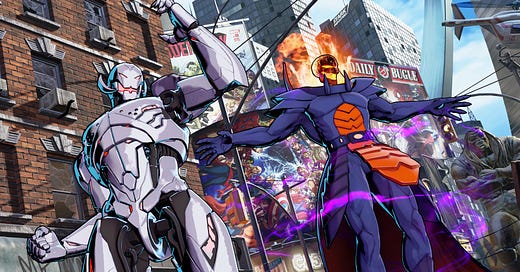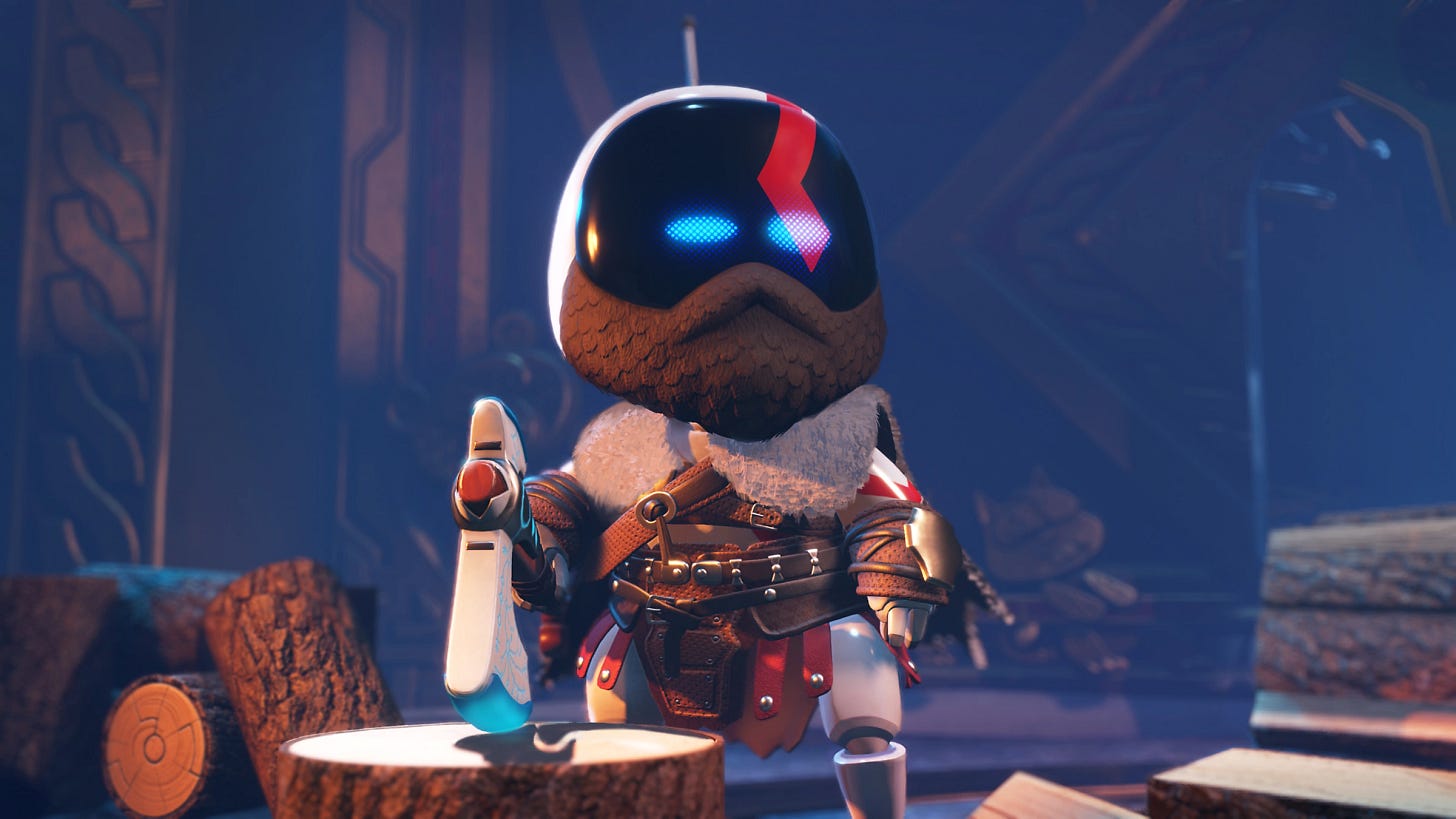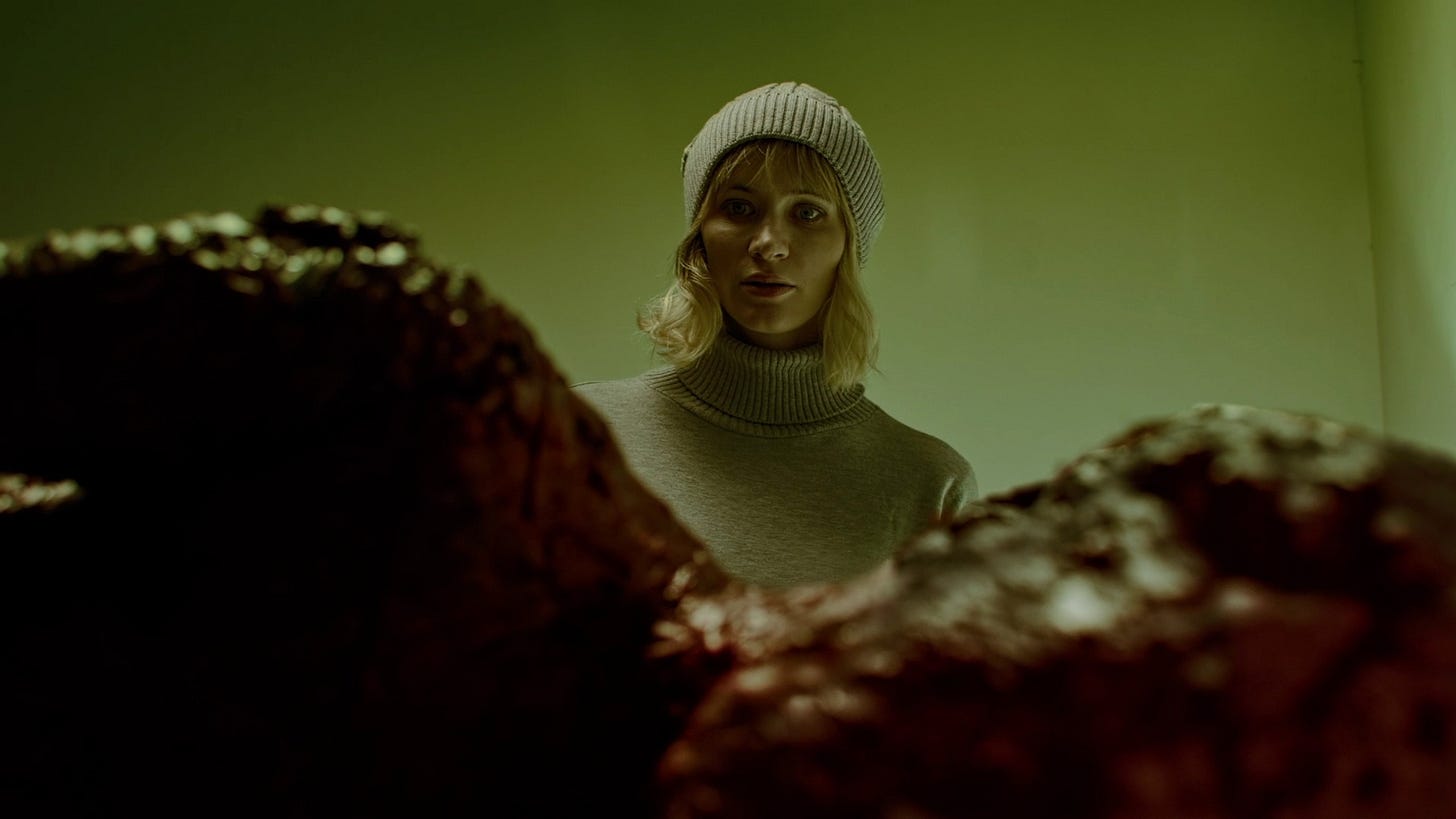The SuperDQP Weekly - January 6, 2024
A stream of consciousness on crossovers (stream of crossciousness?)
Between a recent fighting game mod and multiple live service phenomena, I have brand crossovers on my mind. I feel really mixed about them. Let’s put those feelings on digital paper.
I’m gonna take you for a game rec
Not only am I recommending another mod this week, it’s the springboard for this week’s whole newsletter! And if you have any experience with the fighting game fandom whatsoever, you’ve probably already heard of this, but I’m relatively inexperienced with the FGC (Fighting Game Community) — and I have some history and beef with the local fighting game scene — and I’m still hyped.
Maximillian Dood’s Marvel vs. Capcom Infinite and Beyond mod finally came out, and MVCI is redeemed!
Anybody who remembers the disastrous reveal and launch of Marvel vs. Capcom Infinite is probably still haunted by the uncannily realistic Unreal Engine renders of cartoonish superheroes and video game characters, alongside the vicious thrashing that Dragon Ball FighterZ gave it in terms of sales and popularity. Before the Beyond mod released earlier this month, MVCI was sitting pretty at a double-digit player count on Steam.
Many fighting game nuts saw potential in MVCI’s gameplay, though, and a large modding team led by FGC streamer Maximillian Dood reworked the game’s art style, soundtrack, and game balance to help bring out the incredible fighter lurking behind the controversy.
The end result is breathtaking. It’s a blast to play locally, and the game’s rollback netcode is just as functional as the vanilla version’s.
Marvel is back, baby.
Downloads and instructions are available at mvcib.com. The mod requires a legal copy of Marvel vs. Capcom Infinite on Windows PC via Steam.
The industry politics of crossovers
As cool as Marvel vs. Capcom Infinite and Beyond is, however, its release got me thinking about the initial launch of the vanilla game again, and what a multifaceted disaster it was.
It wasn’t just the game’s artistic direction; it was the marketing, speculated interference from Disney, Capcom’s much-beleaguered DLC practices, and competition from other, more appealing fighting games that led the game to land with a critical and commercial thud.
The story of MVCI’s release is fascinating, all the way up to its redemption arc this year. I dare say it’s a more interesting story than Dragon Ball FighterZ, the game that ultimately defeated it in the sales charts, enjoyed a few years of popularity, and finally saw a patch this year that gleefully broke the game’s balance.
It’s a mesmerizing tale of mysteriously possible corporate subterfuge, with Disney giving the appearance* of pushing Capcom to forsake longtime MVC character favorites like the X-Men or Doctor Doom in favor of characters popular in the Marvel Cinematic Universe at the time. After all, Disney didn’t own 20th Century Fox when MVCI was in development, and Fox’s X-Men film franchise was a weak competitor to Disney’s entertainment juggernaut. (Pun not intended, but welcomed nonetheless.)
*(Also, a lot of this is speculation. The lack of X-Men in MVCI was very conspicuous, considering the historical influence that the series has had on Capcom’s Vs. games over the decades, but I don’t think that any pressure from Disney was explicitly confirmed or denied.)
Even with the Beyond mod, MVCI would likely not be the game it is without the corporate politics of 2016 and 2017. The end product is a brutal reminder of the backroom deals and compromises that have to happen for big crossover events to occur. And for many consumers looking at MVCI, those compromises were a deal breaker.
In the years since, big crossovers have become much more common. Not too long after MVCI’s release, Fortnite launched its battle royale mode, turning it into a live service tour-de-force that continues to this day with skins based on everything from Star Wars to Jujutsu Kaisen to Snoop Dogg.
2018, just the following year, saw the release of Avengers: Infinity War, complete with an internet meme mocking its status as “the most ambitious crossover event in history.” A few months after that, Nintendo launched Super Smash Bros. Ultimate, which would cross over with many non-Nintendo franchises both at launch and afterward through season passes.
It’s normal now. Final Fantasy XVI in Tekken 8. Cyberpunk Edgerunners in Guilty Gear Strive. Skibidi Toilet in Fortnite, for heavens’ sake!
There was a time once in my life where I’d see the trailer for Sonic the Hedgehog’s appearance in Super Smash Bros. Brawl and lose my mind, but now the most I can muster for these kinds of announcements is a shrug and an “Okay. Sure. Why not.”
I mentioned last week that I had mixed feelings on Astro Bot’s reliance on brand recognition, but I didn’t really unpack them that week. You know what? It’s time now.
Astro Bot is a love letter to the PlayStation brand. For every reference to a well-known property like Horizon or God of War, there’s an adoring homage to a long-forgotten game like Wild Arms or Siren. But even as I literally squeed at seeing a little robot version of Leon S. Kennedy, I couldn’t shake the feeling that the line between “homage” and “marketing ploy” was getting very blurry.
It didn’t help that each world culminates in a level based entirely on a specific PlayStation game like Uncharted or God of War: Ragnarok, reinforcing the idea that this lovely and genuinely fun platformer was being weaponized to sell me games I’m in no real hurry to play. There sure were a lot of Horizon references that I would have gotten if only I’d spent the $60 on Forbidden West and sunk the time into it.
Back when Super Smash Bros. Ultimate released, I made a video about this line between homage and marketing, praising Nintendo’s inclusions as “honoring” specific games that have otherwise flown under the radar. With crossovers all over the gaming landscape today, often using FOMO to sell microtransactions in games like Fortnite, I’m not as optimistic today.
I suppose, with Marvel and DC and Capcom and Nintendo and Epic Games opening those Pandora’s Boxes all those years ago, this kind of entertainment phenomenon was inevitable, and my tiredness will do nothing to stop people from being excited about it.
And let me be clear: I don’t want to pooh-pooh people who are earnestly excited about a lot of these crossovers. A lot of the people actively working to make these crossovers happen are as excited as the fans are to see them, and that excitement can be contagious.
But all the same, it does make me feel tired and exhausted for this to be the norm in the live-service video gaming space. Especially when the alternative norm in the live-service video gaming space is the gacha nightmare seen in games like Genshin Impact and Zenless Zone Zero.
There’s not an easy way to conclude this newsletter. I live in a glass house; I know I’m going to buy the inevitable Smash Bros. entry made for Nintendo’s next console because I have a lot of childhood nostalgia for the franchise. I’m enjoying Marvel vs. Capcom Infinite and Beyond because it’s such a vivid labor of love from a devoted fanbase.
And yet the tiredness remains. And looking at the big-budget entertainment landscape, with new Avengers films on the way and Fortnite doing as well as it’s ever done, it doesn’t look like that tiredness is going away anytime soon.
A palate-dirtying wishlist recommendation
For my own sake, I’m going to wrap this newsletter up with an upcoming game bursting with creativity.
Tenebris Somnia is a mixed-media horror game, bouncing back and forth between classic survival-horror puzzle-solving and high-definition live-action cutscenes.
That kind of mixed-media interplay is nothing new; it’s been around since at least The 7th Guest in 1993 and continues in modern games like Alan Wake II and Hellblade: Senua’s Sacrifice. But Tenebris Somnia makes that transition particularly jarring in a way that compliments its overall design.
It brings with it a mood all its own, embracing its low-budget horror film roots while carrying a surprisingly somber tone.
The game is currently slated for release on Windows PC via Steam. A demo is also currently available via Steam. The game will be Steam Deck verified.










